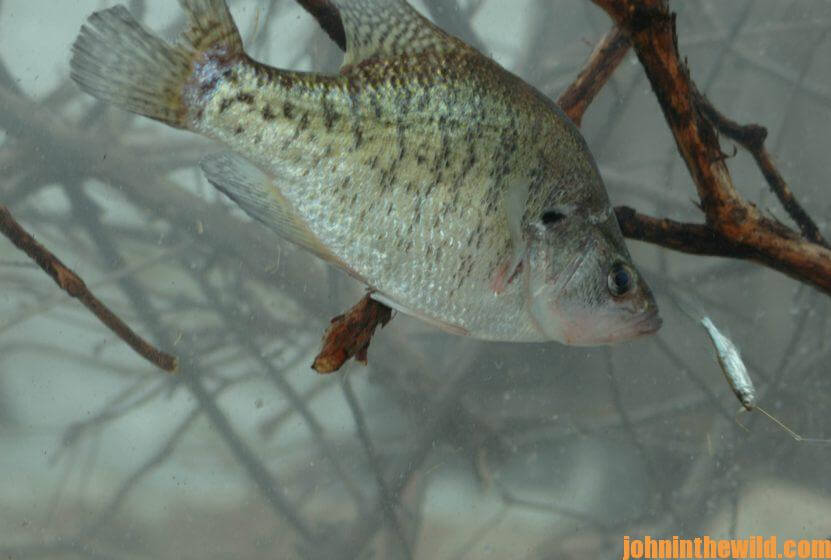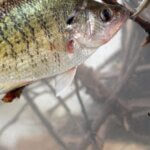Editor’s Note: During the summertime, crappie often will move out to the river channels, especially if they are in a lake that is being used to generate hydroelectric power, because the current being pulled through the lake usually will have the coolest and most highly-oxygenated water. When the current begins to run, the baitfish may go on a feeding spree, and then the predator fish, like the crappie, will follow the baitfish.
One of the most-productive tactics I’ve learned in the last few years is to use a bass technique to catch crappie on these creek channels in the summer months. By pinpointing underwater cover or 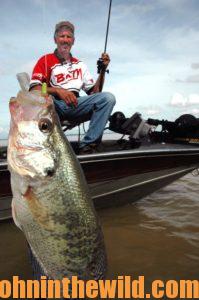 brush on the edges of main river channels, an angler will have discovered a place where baitfish can hold that breaks the current in an area where the water is so cool and highly oxygenated. This location probably will hold many types of fish – bass, crappie, white bass and even hybrids and stripers. All these predators cruise this area to find baitfish.
brush on the edges of main river channels, an angler will have discovered a place where baitfish can hold that breaks the current in an area where the water is so cool and highly oxygenated. This location probably will hold many types of fish – bass, crappie, white bass and even hybrids and stripers. All these predators cruise this area to find baitfish.
One of the most-effective lures for catching bass during summer in the cover is the 3/4-ounce Hopkins jigging spoon (https://hopkinslures.com/), which can be lowered down through the cover and fished vertically where the bass are holding. But what every experienced bass fisherman knows is that this tactic also catches crappie – big crappie. However, there’s a slight modification that should be made to the jigging spoon for the bait to produce the maximum number of fish with the least amount of hassle.
All anglers realize the advantage of having sharp hooks to take fish. Although a sharp hook penetrates deeper and faster that a dull hook, a sharp hook also will penetrate cover faster and easier. And, because a sharp hook cuts the fish’s skin, it also leaves a bigger hole in the fish’s mouth that may result in the fish escaping the hook. Therefore, when using a 3/4-ounce jigging spoon to catch crappie, take a small file, and barely pass it over the tip of each treble hook on the jigging spoon, since crappie have delicate, paper-like mouths. By slightly dulling the hook in this manner, the hook punches a hole in the mouth of the crappie, rather than slicing the mouth of the fish. That hole will be harder for the hook to work free from when the angler is reeling the crappie up from deep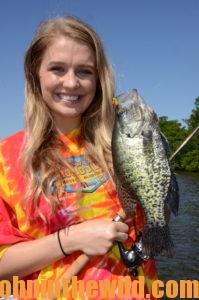 water. A dull hook is also much easier to get out of cover than a sharp hook.
water. A dull hook is also much easier to get out of cover than a sharp hook.
When using the jigging-spoon tactic in cover on the edge of an old river channel, the angler doesn’t have to set the hook. By simply reeling down when he or she feels the strike, the fisherman will allow the hook to poke through the tender mouth of the crappie without making a large hole. Slow, steady pressure will bring the fish out of the cover and into the boat.
In the wintertime, when the crappie are once again moving out to the deep river channel in search of stable water conditions, this same method will produce big slabs all winter long. Since the 3/4-ounce jigging spoon is a large bait, an angler will catch few if any little crappie on it. However, at the end of a day of using this deep-water technique, sportsmen usually have more pounds of crappie in their live wells or ice chests than they’ll have had if they’d utilized smaller baits and caught larger numbers of little fish.
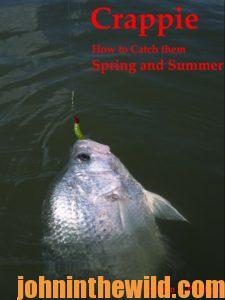 To learn more about fishing for crappie, check out John E. Phillips’ book, “Crappie – How to Catch Them Spring and Summer,” available in Kindle and print versions at http://amzn.to/WGaJLT and Audible at Click here for the Audible link.
To learn more about fishing for crappie, check out John E. Phillips’ book, “Crappie – How to Catch Them Spring and Summer,” available in Kindle and print versions at http://amzn.to/WGaJLT and Audible at Click here for the Audible link.
Tomorrow: How to Catch Crappie in the Mouths of Creeks



